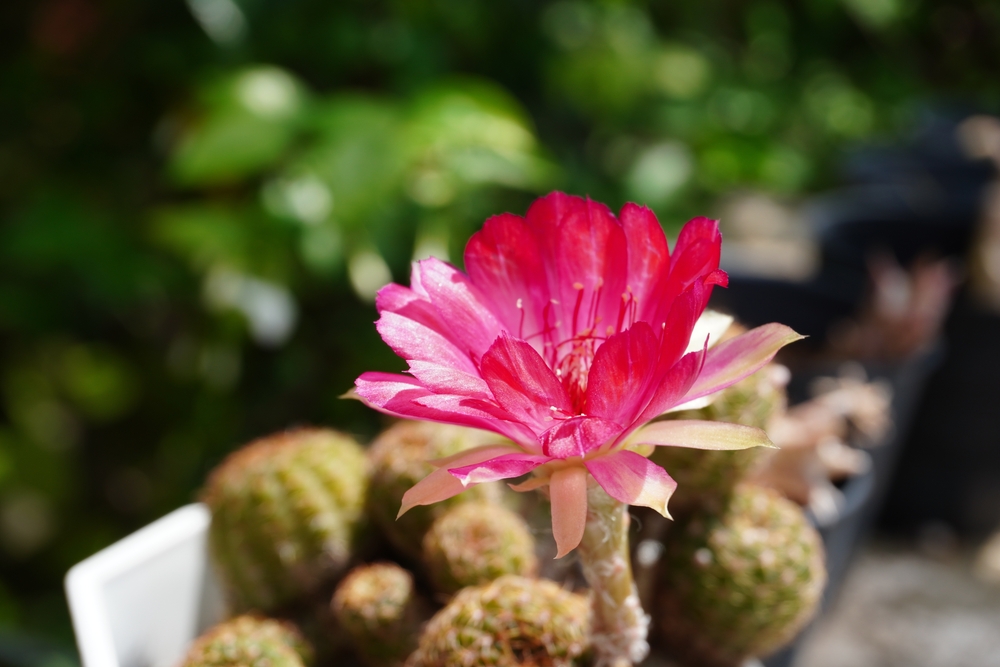
Succulents and cacti are low-maintenance plants that give a quirky touch to indoor and outdoor spaces. There are plenty of full sun succulents and cacti to choose from that will brighten any space in your home garden.
Some popular full sun succulents and cacti include aloe, jade plants, and prickly pear cacti. They’re perfect for anyone who wants to add a little bit of greenery to their space but doesn’t have much time to care for plants. You can also grow Morrocan mounds, aeoniums, and sedum for aesthetics.
If you’re looking for some sun-loving plants to add to your collection, succulents and cacti are great options. Here are 15 full sun varieties that are sure to thrive in your yard with little tips and tricks to take care of them.
1. Agave

Agaves are also known as ‘Century plants’ because they can live for up to 30 years without flowering.
They have a rosette shape with thick and fleshy leaves with sharp tips. The agave flowers are yellow or white and grow on a stalk.
Agaves can grow very tall, almost up to 10 feet (3 m), are drought-tolerant, and can thrive in hot, dry conditions.
There are many species of agave, but some of the most popular ones include the blue agave, used to make tequila, and the American agave used to make mezcal.
2. Aloe
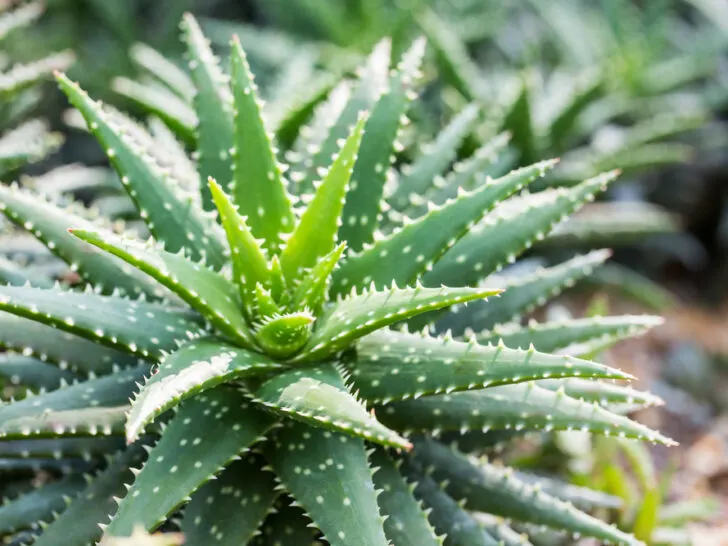
Aloe plants bloom every year in the middle of winter and summer with long stalks of red or orangish shade. Aloe flowers are on tall spikes up to three feet (0.9 m) and range in color from yellow to red.
Aloe plants can grow even in poor soil types and dry weather. You can grow aloe outdoors year-round if you live in a warm climate.
3. Aeoniums ‘Tree Houseleek’
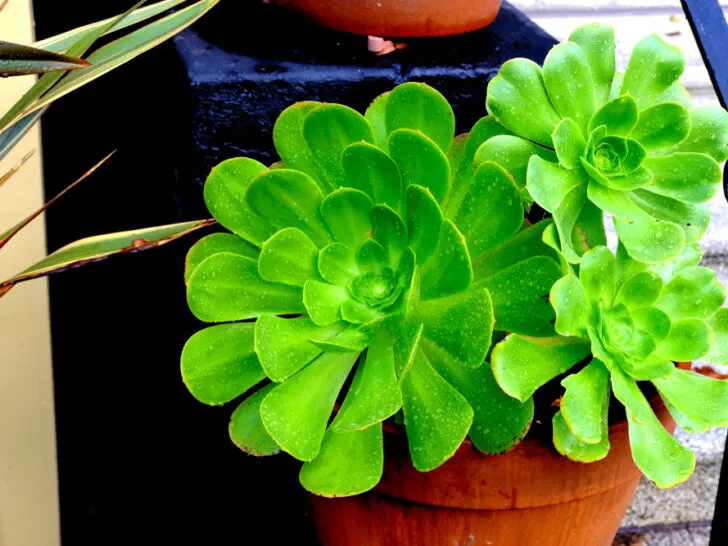
If you’re looking for a succulent that can tolerate full sun, you can’t go wrong with an aeonium.
These rosette-like succulents have symmetrical spoon-shaped leaves and yellowish starlike flowers that bloom at the center in spring. But these are primarily monocarpic and die if they bloom.
Aeoniums can range in color from deep burgundy to bright green. Some varieties even have variegated leaves. No matter what color you choose, these plants are sure to add interest to your garden.
Aeoniums are well-suited to hot, dry climates and can tolerate full sun. They’re also perfect for growing in containers.
4. Senecio mandraliscae ‘Blue Chalk Sticks’
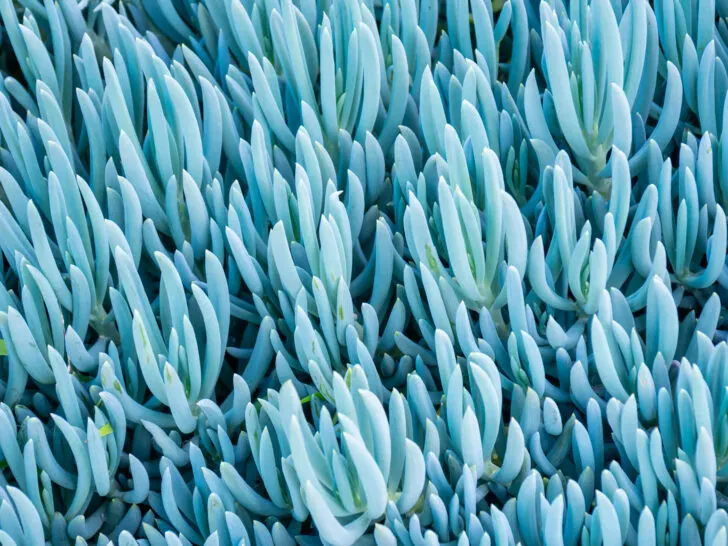
Senecio mandraliscae, commonly known as blue chalksticks, is a succulent plant native to South Africa. It is a member of the aster family and has bluish-green stems with small, white flowers. The plant is drought-tolerant and prefers full sun.
This evergreen succulent can grow up to 1.5 feet (45 cm) tall and 2 feet (60 cm) wide. It’s easy to care for and only needs to be watered once a week.
Senecio mandraliscae is also a winter grower and heat dormant. It can be grown anywhere, be it in succulent arrangements, rock gardens, or containers. But these are most toxic to pets like dogs, cats, and horses.
5. Sedums ‘Stonecrops’

Speaking of full sun succulents and cacti, Stonecrops can never be left behind. Sedums, also known as stonecrops, are a large group of succulent plants that thrive in sunny, dry conditions. They are native to Africa and North America and are comparatively low-growing trailing succulents.
With water-storing leaves and 5-6 petalled flowers, many sedum species have unique growth habits and flower colors.
Most sedums thrive in the summer. On the other hand, some sedum variants are better suited for winter, tolerating freezing temperatures.
6. Sempervivum ‘Hens and Chicks’

Sempervivum is a genus of about 40 species of succulent plants known as hens and chicks. They are mainly native to Europe, North Africa, and the Mediterranean.
This hardy plant can grow up to 4 inches (10 cm) tall and blooms with reddish or bluish-colored flowers through stalks. This plant is also known for its ability to tolerate full sun, making it an ideal choice for those who don’t have a green thumb.
The name ‘hens and chicks’ is often referred to as the way of propagating these beautiful succulents. One can easily cut off the chick or the baby succulent from its hen or mother part and plant it in another place to reproduce.
7. Crassula ovata ‘Jade Plant’

If you’re looking for a large succulent that can tolerate full sun, the Crassula ovata, or jade plant, is a great option. Native to South Africa, this succulent is drought-resistant and can handle long periods of direct sunlight.
The Jade Plant (aka ‘money plant’) stands as a symbol of good luck and can grow up to 4 feet (1.22 m) tall.
Although it’s not technically a cactus, it does have small, fleshy leaves that store water, making it an excellent choice for hot, dry climates. You’ll need to water it before fall to give it enough rest in winter.
These plants often have a variety of colors added to their leaves, from dark green to yellow, with reddish hues on the edges when stressed under sunlight.
Do note the differences between stressed-out colors and sunburn on the succulents you care about. Here’s a 3-min video guide on YouTube:
This evergreen plant is also easy to care for, requiring minimal watering and fertilization. Due to the thick woody trunk, these succulents are a popular choice for making bonsais.
8. Opuntia ‘Prickly Pear Cactus’

Opuntia, or ‘prickly pear cactus,’ is the most unique plant in our 15 full sun succulents and cactus category.
Prickly pear cactus is native to arid and semi-arid regions of North and South America. Still, it has been introduced to other parts of the world, including Europe, Africa, and Australia.
Opuntia is a genus of cactus that includes about 150 species. The most common type of prickly pear cactus is characterized by green paddle-shaped prickly leaves with prominent spines and reddish fruit that grows on the pads of the plant.
The plant is drought-resistant and can tolerate poor soil conditions. The prickly pear cactus is an excellent choice for a xeriscape garden or adding a touch of desert to your home landscape.
Besides, prickly pear cacti are used in various ways, including as food, medicine, and animal feed. The cactus pads and the fruits can be eaten raw or cooked.
9. Cereus
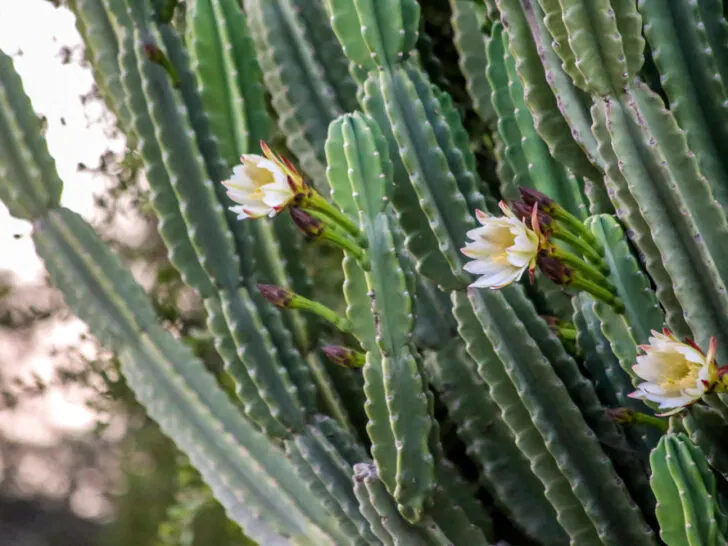
Cereus is a genus of around 33 columnar cacti species, including some of the most popular species with ribs and spines, such as the saguaro and the Peruvian apple cactus. Native to arid regions of South America, Cereus cacti are well-suited to hot, dry climates.
They are slow-growing plants that can reach heights of 20 feet (6 m) or more in their natural habitat. They are usually much smaller in cultivation, but they can still make impressive specimen plants. They mainly bear nocturnal white-colored, fragrant flowers.
10. Echinocereus (Hedgehog Cactus)
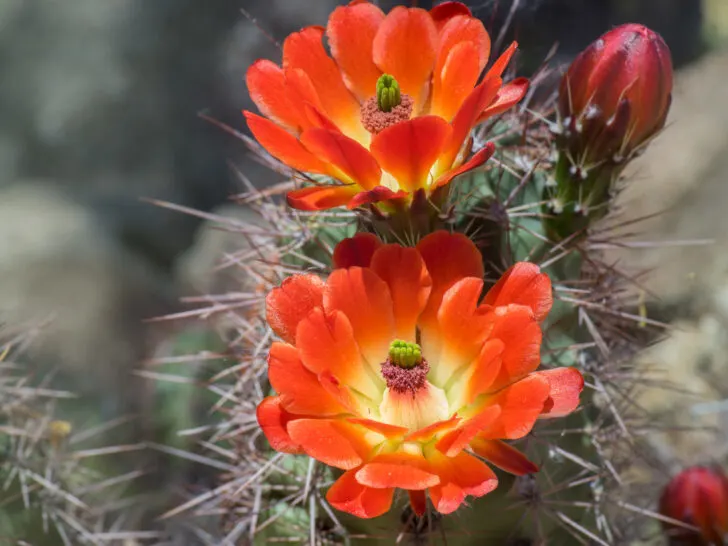
Echinocereus, or hedgehog cactus, is another full sun succulent perfect for hot, dry climates. The Hedgehog cactus is relatively easy to care for, requiring only occasional watering and protection from extreme temperatures.
There are more than 60 species of Echinocereus. The plants are native to Mexico, and most species grow in the deserts of the southwestern United States. These cacti can withstand long periods of direct sunlight.
As the name suggests, these cacti have densely packed spines like a hedgehog that range in color from white to red to yellow.
Echinocereus cacti are small to medium-sized plants that range in height from 6 inches (15 cm) to 36 inches (91 cm). The plant’s flowers are usually pink or red and bloom in spring or summer.
11. Ferocactus
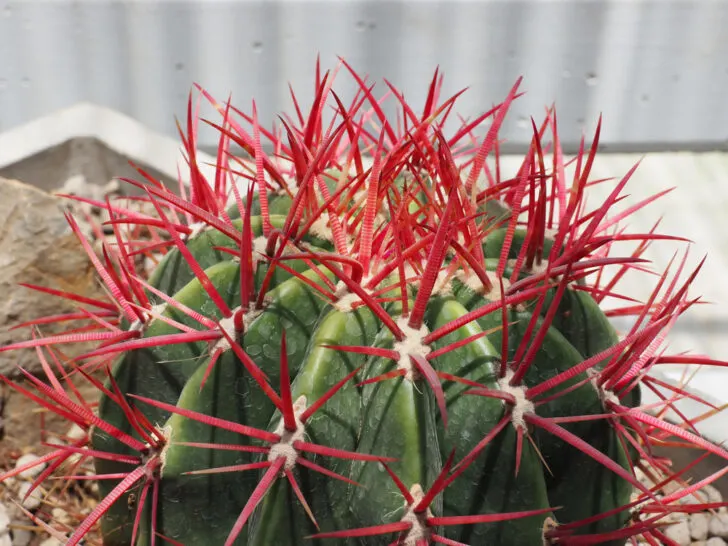
Ferocactus, also known as the barrel cactus, is native to the deserts of North America. The plant is easily recognizable by its large, round shapes like a barrel and fiery red flowers which bloom in the summertime.
The plant is also known for its thick, spiny stem, which can grow up to 3 inches (7.6 cm) long. Ferocactus are slow-growing plants that can live for up to 100 years. When grown in pots, they should be repotted every 2-3 years.
Ferocactus are drought tolerant and can thrive in harsh desert conditions, i.e., they can easily withstand total sun exposure. In fact, they prefer full sun and will not do well in shady areas.
12. Sedum coppertone
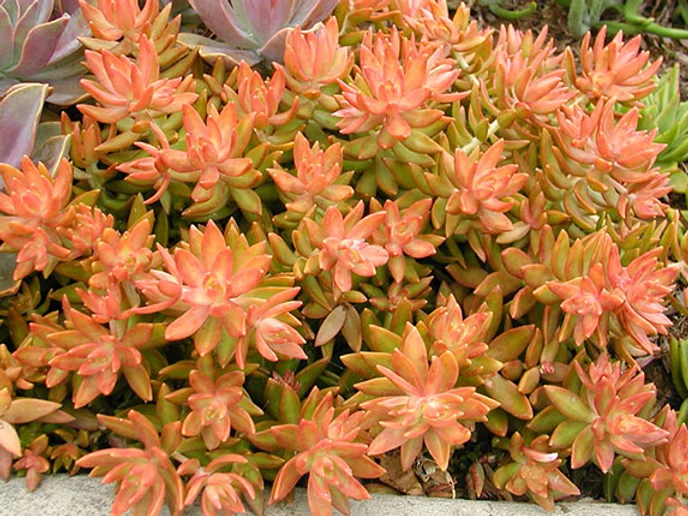
Sedum Coppertone is another full sun succulent, perfect for hot, dry climates. It’s a low-growing plant with tiny, pale green leaves which gets a copperish hue when exposed to full sun. The puffy yet pointed leaves have a rosette pattern with a whitish tip.
The plant typically blooms in late summer producing small clusters of white star-shaped flowers. A few other varieties of Coppertones can bloom even in spring with pinkish flowers. This plant is native to Mexico and can grow up to 36 inches (91 cm) tall.
This succulent has a unique look and can be propagated easily through stem cuttings. Once established, it’s highly tolerant of neglect and it won’t die that quickly.
13. Pachyphytum
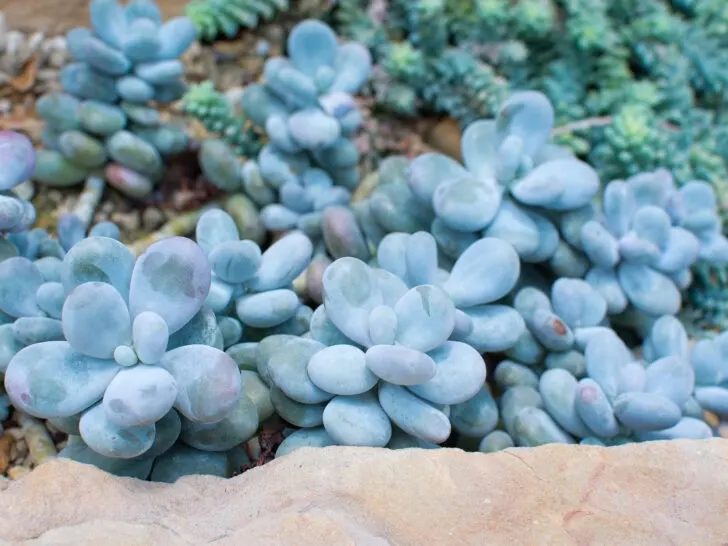
Pachyphytum is typically stemless or short-stemmed succulents with fleshy leaves in rosettes. The leaves are often blue-green or silver-gray and may be covered in a powdery substance known as farina. Flowers are borne on long stems ranging from white to pink.
Pachyphytum is an easy-to-grow succulent and makes excellent additions to both indoor and outdoor gardens.
14. Moroccan mound
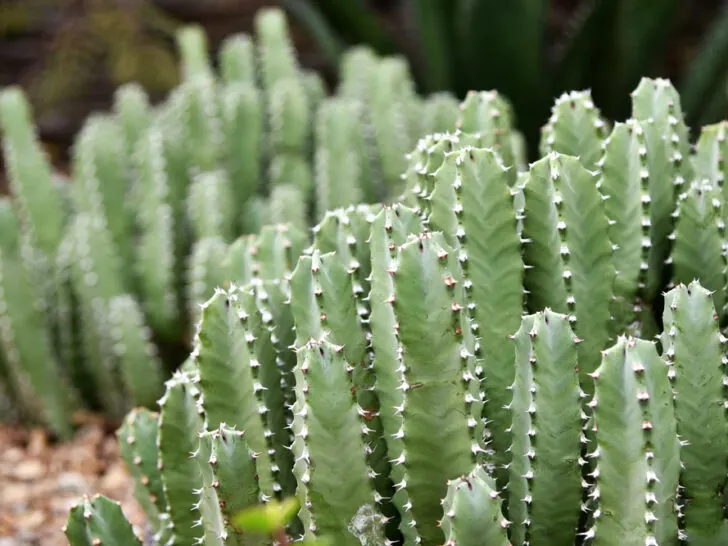
Moroccan mounds are a type of succulent that thrives greatly in full sun. They are native to the deserts of Morocco, where they grow in rocky, sandy soils. But they can be quickly produced in USDA hardiness zones 9 to 11.
Moroccan mounds form a pale green 4-sided elongated tubular body with small pointy spines. These grow best, up to 2 feet (61 cm) tall, in well-drained soils. These succulents have small light yellow blooms, typically from winter to spring.
They are excellent for rock gardens or used as a border in xeriscaping. They can be propagated from stem cuttings, but clean them thoroughly before planting.
15. Ocotillo
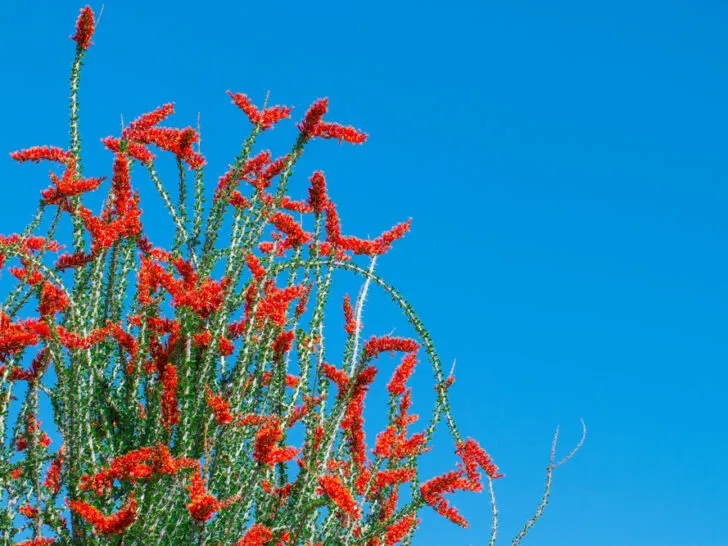
Native to the deserts of Mexico and the southwestern United States, Ocotillos (Fouquieria splendens) are heat-tolerant and can thrive in full sun exposure. They’re relatively easy to care for if you keep them in well-drained soil and water them sparingly.
These plants bear long, mostly leafless, spiny stems. It has an upright, slender growth habit and can reach heights of up to 25 feet (7.6 m) with a trunk around 1 foot (30 cm) in diameter.
In the spring and summer, ocotillo produces small, red, or yellow flowers that attract hummingbirds.
Tips For Growing Succulents In Full Sunlight
Full sun succulents and cacti are beautiful, easy-to-care-for plants that thrive in sunny conditions. Here are some tips for growing full sun succulents and cacti:
- Choose the right variety. Not all succulents can handle full sun. Look for types in the given list above that you specifically find suitable.
- Choose a sunny spot. Full-sun succulents need at least 6-8 hours of direct sunlight daily.
- Water only when necessary. Water your succulents deeply, but only when the soil is completely dry.
- Fertilize sparingly. Succulents don’t need much fertilizer to stay healthy, so you only need to fertilize them in the spring. Use a general-purpose fertilizer at half the normal rate. Only fertilize plants that have been planted for up to two years.
Conclusion
These 15 full sun succulents and cacti are perfect for adding a touch of desert to your home. These hardy plants can tolerate long periods of direct sunlight, making them ideal for bright, sunny spaces.
With a wide variety of shapes, sizes, and colors, there’s a sun-loving succulent or cactus to suit any taste. These plants are easy to care for, require minimal water, and thrive in even the most challenging environments.
So whether you’re a seasoned gardener or a complete novice, these plants will surely bring success.

